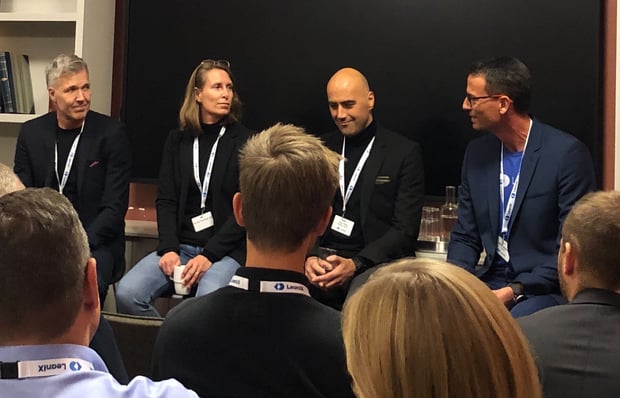
Whether enterprise architecture (EA) belongs in IT was one of the topics under discussion at our recent LeanIX Connect Nordics in Stockholm last month. The question came up when one of our partners asked if we were seeing a trend in organizations where EA had moved out of IT and into the business proper (e.g., reporting into the CFO or CEO functions).
It turns out, one of LeanIX's Senior Consultants, Dominik’s Söhnle, wrote his master's thesis on this exact topic. Here's what he had to say:
Approximately 80% of EA teams are under the CIO, however only 25% want to stay there. The rest would prefer to sit under business strategy, or the CEO, to be able to drive business value.
As an attendee myself, this brought up a lot of questions for me:
- Can’t EA drive business value from IT?
- Does it really matter where EA sits? That is, wouldn't an EA practice function the same regardless of where it's found on the org chart?
- More importantly, should we really be making such a distinction between IT and Business? Don't we all have the same goals?
- Darko Tilldal, CISO at the Granitor Group
- Maria Säfverström, Senior Enterprise Architect at Telia Company
- Thomas Teglund, Lead Enterprise Architect at Securitas

Where is EA within your Organization?
Steffen first asked panelists to share where EA sat within their organizations. Maria Säfverström alone said that she sits on the "business side’ of the organization. She elaborated by explaining that she serves as the business counterpart to the enterprise architect on the IT side of the organization. She also emphasized that one of the reasons she joined Telia was due to EAs strong connection to the business.
“We view the whole enterprise from a business perspective (not the IT perspective)," Maria said.
"This was a big change for me as an EA. Suddenly I have domains like product, business performance, process, customer experience, legal, and innovation listening and asking for advice.”
In contrast to Maria's experience, when we put the question to the audience in the room, it turned 100% found themselves on the IT side of the business.
As a follow-up, Steffen Wittmann posed the question, “Why do you think EA teams want to make the shift to the business, and do you think it will have the desired effect?”
What does EA gain from sitting on the business side?
The belief among the panelists was that EA is a core component in delivering business value. They all saw themselves as acting on behalf of the business to support business objectives. I wondered if, perhaps, the reason some EAs wanted to move to the business was because they believed they would have more visibility and more purpose there.
As if to echo my thoughts, at least one attendee was not totally confident that shifting to the business would would have the desired effect. Mats Berglund from Ericsson, wanted to understand why Enterprise Architects have a “kind of complex” about where they sit. Instead of asking whether we should report into this or that part of the organization, he said, “We should be asking ourselves, as EAs, what are we giving the business?”
Mats said it didn't matter that EA was in IT. Enterprise Architects should continuously prove their value to the business wherever they sit. Their contribution, after all, is what makes EAs credible advisors to the business.
Returning for a moment to Dominik’s Söhnle’s thesis, he makes the point there that part of this "IT or the business" tension arises from a lack of business focus in some of the EA tools on the market. Given the need and desire for EAs to prove themselves to the business, he believes this will change in the near future.
Why is there a lack of business focus in EA tools? According to Dominik’s research, it's due to a strong focus on technical modeling in traditional EA practices. The focus instead, he believes, should fall more on aligning EA with market trends and digital drivers. It is through this focus that EA can become true advisors to the organization.
Why does it feel like IT and the Business are two opposing entities?
To dig deeper into these issues, Steffen asked about the perceived divide between IT and the business.
Maria responded that individual team objectives in different parts of the organization don’t always seem to match up, despite the common company goals. To illustrate her point, she referred to a tendency on the business side to focus on growth, for example, while IT focuses on things like efficiency and doing more with less.
There followed some discussion in the room that included several interesting examples of how these competing interests lead to poor communication between the two business functions. Frankly, it sounded like there was plenty of frustration on both sides.
As the conversation continued, Darko Tilldal raised the question: “Why does business go out and buy solutions and products without talking to IT? Because IT is too slow. We are focused on large digital transformations and migrations/modernizations, and don't always have the bandwidth to support the fast speed of change from the business side.”
All this talk brought us around to a critical question for the panelists, “What if the EA function was handed over to the business - would that make it all of a sudden more capable of driving business value?”
The panelists all agreed that this probably wasn't the silver bullet. The EA role won’t change by doing this. Proving value and talking the same language is the key requirement, as is a true understanding on the part of EAs around what really drives business results.
So, if moving the function isn’t the answer, how should organizations bring IT and the business together?
To answer that question, Thomas Teglund focused on collaboration and 1:1 stakeholder meetings to understand pain points. He said, "It’s worth putting in the effort and getting airtime with the business stakeholders if you’re going to show your value as EA".
The panelists also recommended skills transfer and up-skilling to ensure that enterprise architects develop the capability to work productively with the business.
Thomas went on to say that he sees the role of business architect becoming more important in the future. Darko agreed and expressed his belief that understanding approaches to business architecture was increasingly going to be part of the modern enterprise architect's skillset.
On the collaboration front, Maria talked about developing "Communities of Practice," – multi-disciplinary teams that work towards a common goal. Bringing together EAs and others from across the organization around a common purpose, she explained, can go along way to getting people on the same page and pulling in the same direction.
As Dominik's research shows, the value of EA isn’t always understood in organizations. For this reason, defining what EA is and articulating exactly how it adds business value is critical, not just for the success of the business, but also for the success of the EA team. These definitions can go a long way towards bridging the perceived gap between EA, IT, and the business.
Our panel also insisted that a shared vision and understanding at the management level of EAs importance can help ensure that employees across the organization support the EA practice and vice versa.
Read this Whitepaper on the EA of Tomorrow to see if you’ve got the skills!

.png?width=140&height=107&name=BTMPlaybook-FI%20(1).png)

